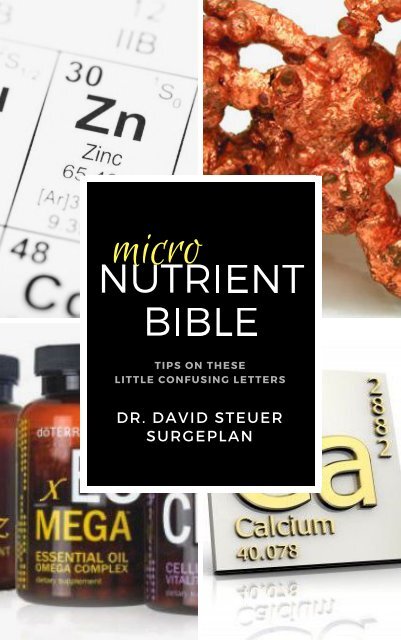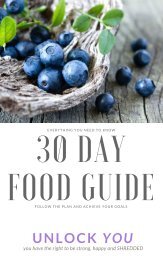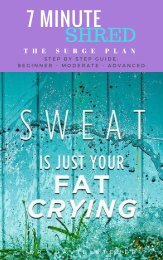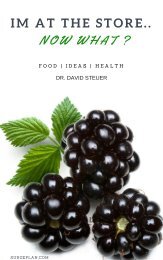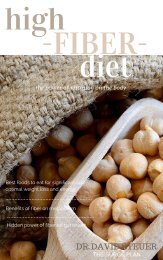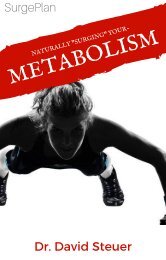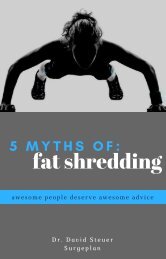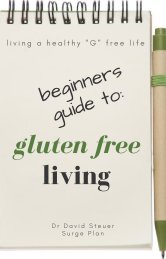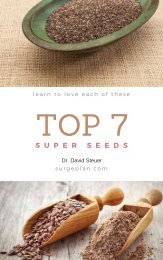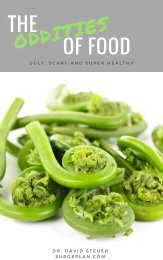micro_NUTRIENT_BIBLE
You also want an ePaper? Increase the reach of your titles
YUMPU automatically turns print PDFs into web optimized ePapers that Google loves.
<strong>NUTRIENT</strong><br />
<strong>BIBLE</strong><br />
<strong>micro</strong><br />
T I P S O N T H E S E<br />
L I T T L E C O N F U S I N G L E T T E R S<br />
D R . D A V I D S T E U E R<br />
S U R G E P L A N
A L R I G H T , S O W H A T E X A C T L Y A R E<br />
M I C R O - N U T R I E N T S , O R M I N E R A L S , O R<br />
V I T A M I N S F O R T H A T M A T T E R . . . ? ? ?<br />
VITAMINS AND MINERALS ARE THE TWO TYPES OF MICRO<strong>NUTRIENT</strong>S. WHILE<br />
ONLY NEEDED IN SMALL AMOUNTS, THEY PLAY IMPORTANT ROLES IN HUMAN<br />
DEVELOPMENT AND WELL-BEING, INCLUDING THE REGULATION OF<br />
METABOLISM, HEARTBEAT, CELLULAR PH, AND BONE DENSITY. LACK OF<br />
MICRO<strong>NUTRIENT</strong>S CAN LEAD TO STUNTED GROWTH IN CHILDREN AND<br />
INCREASED RISK FOR VARIOUS DISEASES IN ADULTHOOD. WITHOUT PROPER<br />
CONSUMPTION OF MICRO<strong>NUTRIENT</strong>S, HUMANS CAN SUFFER FROM DISEASES<br />
SUCH AS RICKETS (LACK OF VITAMIN D), SCURVY (LACK OF VITAMIN C), AND<br />
OSTEOPOROSIS (LACK OF CALCIUM).<br />
TYPES OF MICRO<strong>NUTRIENT</strong>S<br />
VITAMINS ARE AVAILABLE IN TWO FORMS: WATER-SOLUBLE AND FAT-SOLUBL<br />
WATER-SOLUBLE VITAMINS ARE EASILY LOST THROUGH BODILY FLUIDS AND<br />
MUST BE REPLACED EACH DAY. WATER-SOLUBLE VITAMINS INCLUDE THE B-<br />
COMPLEX VITAMINS AND VITAMIN C. VITAMINS B6 AND B12 ARE TWO OF<br />
THE MOST WELL-KNOWN B-COMPLEX VITAMINS. SINCE THEY ARE NOT LOST<br />
AS EASILY AS THEIR WATER-SOLUBLE COUNTERPARTS, FAT-SOLUBLE VITAMIN<br />
TEND TO ACCUMULATE WITHIN THE BODY AND ARE NOT NEEDED ON A DAILY<br />
BASIS. THE FAT-SOLUBLE VITAMINS ARE A, D, E AND K.<br />
S U R G E P L A N
A L R I G H T , S O W H A T E X A C T L Y A R E<br />
M I C R O - N U T R I E N T S , O R M I N E R A L S , O R<br />
V I T A M I N S F O R T H A T M A T T E R . . . ? ? ?<br />
MINERALS ARE ALSO AVAILABLE IN TWO FORMS:<br />
MACROMINERALS AND MICROMINERALS.<br />
MACROMINERALS ARE NEEDED IN LARGER AMOUNTS<br />
AND INCLUDE THE FOLLOWING:<br />
CALCIUM<br />
MAGNESIUM<br />
PHOSPHORUS<br />
SODIUM<br />
POTASSIUM<br />
MICROMINERALS ARE ONLY NEEDED IN TRACE<br />
AMOUNTS AND INCLUDE THE FOLLOWING:<br />
IRON<br />
COPPER<br />
IODINE<br />
ZINC<br />
FLUORIDE<br />
S U R G E P L A N
A L L A B O U T " M I C R O "<br />
There are dozens of types of whole grains. here are<br />
some of the most common ones.<br />
MINERALS<br />
The five major minerals in the human body are<br />
calcium, phosphorus, potassium, sodium, and<br />
magnesium. In the context of nutrition, a<br />
mineral is a chemical element required as an<br />
essential nutrient by organisms to perform<br />
functions necessary for life. Minerals originate<br />
in the earth and cannot be made by living<br />
organisms.<br />
VITAMINS<br />
A VITAMIN IS AN ORGANIC COMPOUND<br />
AND A VITAL <strong>NUTRIENT</strong> THAT AN<br />
ORGANISM REQUIRES IN LIMITED<br />
AMOUNTS. IT MUST BE OBTAINED<br />
THROUGH THE DIET<br />
OTHER MICRO<strong>NUTRIENT</strong>S<br />
AMINO ACIDS, TRACE ELEMENTS AND FATTY<br />
ACIDS.<br />
THESE UNCLASSIFIED INTO GROUPS, BUT<br />
RATHER ARE CONSIDERED "SUPPLEMENTS"<br />
FOR A HEALTHY DIET AND BODY FUNCTION.
Calcium is important for the proper<br />
contraction of muscle cells, including<br />
millions of heart muscle cells. It is<br />
needed for the conduction of nerve<br />
impulses and, therefore, for optimum<br />
heartbeat. Calcium is also essential for<br />
the hardening and stability of our bones<br />
and teeth. It is also needed for the<br />
proper biological communication<br />
among the cells of the cardiovascular<br />
system and most other cells, as well as<br />
for many other biological functions.<br />
S U R G E P L A N
How much do we need?<br />
1000 milligrams a day<br />
Where can we get it?<br />
Dairy products, kale, fortified cereals,<br />
green leafy vegetables, tofu<br />
S U R G E P L A N
Why do we need it?<br />
Zinc is used by numerous enzyme<br />
systems as an auxiliary factor (co-<br />
enzyme). A zinc deficiency can lead to<br />
growth disorders, skin diseases and an<br />
increased susceptibility to infections.<br />
Zinc is required by different enzymes in<br />
metabolism and pH regulation, supports<br />
a strong immune system, helps wounds<br />
heal.<br />
S U R G E P L A N
How much do we need?<br />
15 milligrams a day<br />
Where can we get it?<br />
Red meats, fortified cereals, some<br />
types of seafood, poultry, whole<br />
grains<br />
S U R G E P L A N
Why do we need it?<br />
Potassium is an electrolyte needed in mainting<br />
proper blood pressure and fluid balance, nerve<br />
impulses, muscle contraction, especially in the<br />
heart.<br />
Potassium is the most important positively<br />
charged electrical particle in our body cells. It<br />
is important for the generation of energy in the<br />
cell metabolism and is needed for the synthesis<br />
of acetyl-coenzyme-A. Potassium is also<br />
necessary for the normal contraction of<br />
muscles, including the heart muscle. It plays a<br />
part in the electrical processes that are needed<br />
for the regulation of nerve impulses and<br />
S U R G E P L A N<br />
activation of the muscles.
How much do we need?<br />
3500 milligrams a day<br />
Where can we get it?<br />
Bananas, potatoes, avocado, leafy<br />
green vegetables, beans, mushrooms<br />
S U R G E P L A N
Why do we need it?<br />
Sodium is vital in muscle<br />
contraction, sending nerve signals<br />
throughout the body, and with<br />
maintaining fluid balance.<br />
S U R G E P L A N
How much do we need?<br />
2400 milligrams a day<br />
Where can we get it?<br />
Table salt, milk, spinach<br />
S U R G E P L A N
Why do we need it?<br />
Phosphorus is present in every cell of our<br />
bodies, with most of it being found in the<br />
bones and teeth. Phosphorus plays an<br />
important role in the body’s use of<br />
carbohydrates and fats, and is needed to make<br />
protein for the growth, maintenance, and repair<br />
of cells and tissues. It also helps the body make<br />
adenosine triphosphate (ATP), a molecule used<br />
to store energy. Phosphorus works with the B<br />
vitamins and also helps with kidney function,<br />
muscle contractions, normal heartbeat and<br />
nerve signalling.<br />
S U R G E P L A N
How much do we need?<br />
1000 milligrams a day<br />
Where can we get it?<br />
Red meats, dairy products, fish,<br />
poultry, whole grains and oats<br />
S U R G E P L A N
Why do we need it?<br />
Magnesium is nature’s calcium<br />
antagonist, and its benefit for the<br />
cardiovascular system is similar to the<br />
calcium antagonist drugs that are<br />
prescribed, except that magnesium is<br />
produced by nature itself. Clinical studies<br />
have shown that magnesium is<br />
particularly important for helping to<br />
normalize elevated blood pressure;<br />
moreover, it can help normalize irregular<br />
heartbeat.<br />
S U R G E P L A N
How much do we need?<br />
400 milligrams a day<br />
Where can we get it?<br />
Dark leafy greens, nuts, fish, beans,<br />
avocados, dark chocolate<br />
S U R G E P L A N
Why do we need it?<br />
Iron is an important component of hemoglobin,<br />
the substance in red blood cells that carries<br />
oxygen from your lungs to transport it<br />
throughout your body. Hemoglobin represents<br />
about two-thirds of the body’s iron. If you don't<br />
have enough iron, your body can't make<br />
enough healthy oxygen-carrying red blood<br />
cells. A lack of red blood cells is called iron<br />
deficiency anemia.<br />
Without healthy red blood cells, your body<br />
can't get enough oxygen=exhausiton. That<br />
exhaustion can affect everything from your<br />
brain function to your immune system's ability<br />
S U R G E P L A N<br />
to fight off infections.
How much do we need?<br />
18 milligrams a day<br />
Where can we get it?<br />
Red meats, fish, poultry, spinach,<br />
nuts, beans, whole grains<br />
S U R G E P L A N
Copper is needed for the formation<br />
of a web structure of collagen in the<br />
blood vessel walls, which provides<br />
extra strength. It also stimulates the<br />
absorption of iron and the<br />
production of haemoglobin, the red<br />
colored substance that is important<br />
for the red blood corpuscles. Copper<br />
is also part of an enzyme that is<br />
needed for the production of the<br />
dark pigment melanin.<br />
S U R G E P L A N
How much do we need ?<br />
How much copper is in a human<br />
body?<br />
The adult body contains between 1.4<br />
and 2.1mg of copper per kilogramme<br />
of body weight. Hence a healthy<br />
human weighing 60 kilogrammes<br />
contains approximately a tenth of<br />
one gramme of copper. However,<br />
this small amount is essential to the<br />
overall human well-being.<br />
S U R G E P L A N
Manganese is an important<br />
secondary factor for bio-catalysts.<br />
For example, it activates enzymes<br />
that play a part in DNA metabolism,<br />
the molecules that contain<br />
hereditary information. A long-term,<br />
serious shortage of manganese will<br />
result in growth inhibitions,<br />
infertility and other serious<br />
disorders.<br />
S U R G E P L A N
How much manganese per day?<br />
The average dietary intake of<br />
manganese in the United States is<br />
estimated at 2.1 to 2.3 mg per day for<br />
men and 1.6 to 1.8 mg for women,<br />
but those on vegetarian diets or<br />
diets emphasizing whole grains may<br />
get as much as 10.9 mg daily.<br />
S U R G E P L A N
Chromium plays an important role in<br />
carbohydrate metabolism, especially<br />
in connection with glucose and<br />
insulin. In most industrialized<br />
countries chromium deficiency is a<br />
secondary contributor to the<br />
growing incidence of diabetes.<br />
S U R G E P L A N
Chromium Picolinate Dosage. Safe<br />
and tolerable levels of chromium<br />
picolinate have not been<br />
established. To prevent chromium<br />
deficiency, the daily recommended<br />
intake is between 50 <strong>micro</strong>grams<br />
(mcg) and 200 mcg for adults and<br />
teenagers. The recommended<br />
dietary allowance of chromium<br />
increases with age.<br />
S U R G E P L A N
SELENIUM<br />
IS AN IMPORTANT ANTIOXIDANT<br />
THAT PROTECTS THE BODY AGAINST<br />
DAMAGE BY FREE RADICALS AND<br />
ASSISTS ITS DEFENCE SYSTEMS.<br />
CLINICAL STUDIES HAVE<br />
ESTABLISHED THAT SELENIUM<br />
PLAYS AN IMPORTANT ROLE IN THE<br />
FIGHT AGAINST CANCER AND<br />
CARDIOVASCULAR DISEASES.<br />
S U R G E P L A N
SELENIUM<br />
MOST PEOPLE CAN GET THEIR RDA<br />
OF SELENIUM FROM FOOD. IN<br />
STUDIES TO DETERMINE IF<br />
SELENIUM COULD AID IN PROSTATE<br />
CANCER PREVENTION, MEN TOOK<br />
200 MICROGRAMS DAILY. THE SAFE<br />
UPPER LIMIT FOR SELENIUM IS 400<br />
MICROGRAMS A DAY IN ADULTS.<br />
ANYTHING ABOVE THAT IS<br />
CONSIDERED AN OVERDOSE.<br />
S U R G E P L A N
and body against biological rusting.<br />
system<br />
U R G E P L A N<br />
S<br />
Vitamin C is the key nutrient for the stability of<br />
blood vessels, the heart and all other organs in<br />
our bodies. Without vitamin C, our bodies<br />
would literally collapse and dissolve, as in<br />
scurvy. Vitamin C is responsible for the<br />
optimum production and function of collagen,<br />
elastin and other connective tissue molecules<br />
that give stability to our blood vessels and our<br />
entire bodies.<br />
Vitamin C is important for fast wound healing<br />
throughout our bodies, including the healing of<br />
millions of tiny wounds and lesions inside our<br />
blood vessel walls. It is the most important<br />
antioxidant in the body. Optimum amounts of<br />
vitamin C effectively protect the cardiovascular
Vitamin C is also a cofactor for a series of<br />
biological catalysts (enzymes), which are<br />
important for the improved metabolism of<br />
cholesterol, triglycerides and other risk factors.<br />
This helps to decrease the risk for<br />
cardiovascular disease. It is an important<br />
energy molecule needed to recharge energy<br />
carriers inside the cells.<br />
S U R G E P L A N
Folic Acid is a very important nutrient for the<br />
production of red blood cells and oxygen<br />
supply. The last three vitamins are good<br />
examples of how these bio-energy molecules<br />
work together in synergy, like an orchestra.<br />
Without proper oxygen transport to all the<br />
cells, their function would be impaired, no<br />
matter how much of the other vitamins you<br />
might take. It is, therefore, important to<br />
supplement your diet as completely as possible<br />
with the right essential nutrients in the right<br />
amounts.<br />
S U R G E P L A N
Taking folic acid for at least one month before<br />
conception reduces the risk of neural-tube<br />
defects, such as spina bifida, by up to 70<br />
percent, according to the Centers for Disease<br />
Control and Prevention. During pregnancy, the<br />
recommended dose jumps to 600 to 800 mcg,<br />
or 0.6 to 0.8 mg.<br />
S U R G E P L A N
Beta-carotene is also called pro-vitamin A,<br />
and is another important fat-soluble<br />
antioxidant vitamin. Like vitamin E, it is<br />
transported primarily in lipoprotein particles<br />
in the bloodstream to millions of body cells.<br />
Also like vitamin E, beta-carotene prevents<br />
these fat particles from rusting and damaging<br />
the cardiovascular system.<br />
Beta-carotene is documented in a rapidly<br />
growing number of clinical studies as another<br />
protective agent against cardiovascular<br />
disease. Similarly to vitamin E, beta-carotene<br />
has been shown to decrease the risk of blood<br />
S U R G E P L A N<br />
clotting.
BIOTIN ACTS AS A COENZYME IN THE BODY<br />
THAT’S NEEDED FOR THE METABOLISM OF<br />
FATTY ACIDS, AMINO ACIDS AND GLUCOSE.<br />
THIS MEANS THAT WHEN WE EAT FOODS<br />
THAT ARE SOURCES OF FATS, PROTEINS AND<br />
CARBOHYDRATES, VITAMIN B7 BIOTIN MUST<br />
BE PRESENT IN ORDER TO CONVERT AND USE<br />
THESE MACRO<strong>NUTRIENT</strong>S FOR BODILY<br />
ENERGY, TO CARRY OUT PHYSICAL ACTIVITIES<br />
AND FOR PROPER PSYCHOLOGICAL<br />
FUNCTIONING.<br />
S U R G E P L A N
Biotin is also a nutrient that helps us<br />
keep a young, attractive appearance<br />
since it plays a major part in maintaining<br />
the health of our hair, nails and skin. In<br />
fact, biotin sometimes gets the nickname<br />
the “H” vitamin, which stems from the<br />
German words Haar and Haut that mean<br />
“hair and skin.” Vitamin B7 biotin is<br />
commonly added to hair and skin beauty<br />
products, although it’s believed to not be<br />
absorbed very well through the skin and<br />
actually must be ingested to be<br />
fully beneficial.<br />
S U R G E P L A N
Vitamin D is essential for optimum<br />
calcium and phosphate metabolism in<br />
the body. Vitamin D is needed for the<br />
growth and stability of the bones and<br />
teeth. For centuries, vitamin D<br />
deficiency was a frequent children’s<br />
condition, causing retarded growth and<br />
malformation. Thus, in many countries,<br />
milk is enriched with vitamin D. Vitamin<br />
D is also essential for optimum calcium<br />
metabolism in the artery walls, including<br />
the removal of calcium from<br />
atherosclerotic deposits.<br />
S U R G E P L A N
Unlike other members of the vitamin alphabet,<br />
vitamin D defies easy classification.<br />
That’s because it could actually be considered<br />
a hormone, since it’s synthesized in the liver<br />
and kidneys.<br />
Another unique aspect of vitamin D is the fact<br />
that, apart from fatty fish oil, vitamin D is rarely<br />
found in food.<br />
The essential nutrient is dependent on body<br />
chemistry — and we need it to function.<br />
S U R G E P L A N
How much do we need?<br />
Around 2000 Iu a day<br />
Vitamin D- fights depression, boosts<br />
immunity, fights disease and<br />
increases metabolism, and weight<br />
loss.<br />
S U R G E P L A N
Vitamin E is the most important fat-soluble<br />
antioxidant vitamin. It protects,<br />
particularly, the membranes of the cells in<br />
our cardiovascular systems. Vitamin E also<br />
prevents free radical attacks and oxidative<br />
damage.<br />
Vitamin E is carried in low-density<br />
lipoproteins (LDL) and other cholesterol<br />
and fat-transporting particles. Taken in<br />
optimum amounts, vitamin E can prevent<br />
these fat particles from oxidizing<br />
(biological rusting) and damaging the<br />
S U R G E P L A N<br />
inside of blood vessel walls.
Vitamin E has been shown to render the<br />
platelets in blood circulation less sticky<br />
and, thereby, keep the blood thin and<br />
decrease the risk of blood clotting.<br />
For adults older than 18 years, pregnant<br />
women, and breastfeeding women, the<br />
maximum dose is 1,000 milligrams daily<br />
(or 1,500 IU). For age-related macular<br />
degeneration, 30 milligrams to 500-600 IU<br />
of vitamin E (alpha-tocopherol) has been<br />
taken by mouth daily for 4-8 years.<br />
S U R G E P L A N
B3-Niacin is an important nutrient,<br />
essential as the cofactor of nicotinamide<br />
adenine dinucleotide (NAD) and related<br />
energy carrier molecules. This energy<br />
carrier molecule is one of the most<br />
important energy transport systems in<br />
the entire body.<br />
Millions of these carriers are created and<br />
recharged (by vitamin C) inside the<br />
cellular energy centres of the<br />
cardiovascular system and the body. Cell<br />
life, and life in general, would not be<br />
possible without this energy carrier.<br />
S U R G E P L A N
B5-PANTOTHENATE IS THE COFACTOR OF<br />
COENZYME A, THE CENTRAL FUEL MOLECULE<br />
IN THE METABOLISM OF OUR HEART CELLS,<br />
BLOOD VESSEL CELLS AND ALL OTHER CELLS.<br />
THE METABOLISM OF CARBOHYDRATES,<br />
PROTEINS AND FATS INSIDE EACH CELL ALL<br />
LEAD TO A SINGLE MOLECULE, ACETYL-<br />
COENZYME A. THIS MOLECULE IS THE KEY<br />
MOLECULE THAT HELPS TO CONVERT ALL FOOD<br />
INTO CELL ENERGY.<br />
THIS IMPORTANT MOLECULE IS ACTUALLY<br />
COMPOSED, IN PART, OF VITAMIN B5 AND THE<br />
IMPORTANCE OF SUPPLEMENTING THIS<br />
VITAMIN IS EVIDENT. AGAIN, CELL LIFE WOULD<br />
NOT BE POSSIBLE WITHOUT THIS VITAMIN.<br />
S U R G E P L A N
Vitamin B6 is the cofactor of<br />
pyridoxal phosphate, an important<br />
cofactor for the metabolism of<br />
amino acids and proteins in<br />
cardiovascular and other cells.<br />
Vitamin B6 is needed for the<br />
production of red blood cells, which<br />
are the carriers of oxygen to the cells<br />
of the cardiovascular system and all<br />
other cells in the body. Vitamin B6 is<br />
also essential for the optimum<br />
structure and function of collagen<br />
fibres.<br />
S U R G E P L A N
Vitamin B12 is needed for the proper<br />
metabolism of fatty acids and certain<br />
amino acids in the cells of our bodies.<br />
Vitamin B12 is also required for the<br />
production of red blood cells. A severe<br />
deficiency of vitamin B12 can cause a<br />
disease called pernicious anaemia, which<br />
is characterized by an insufficient<br />
production of blood cells.<br />
B12 has been shown to increase energy,<br />
and speed weight loss with a high fiber<br />
diet.<br />
S U R G E P L A N
The National Institutes of Health (NIH)<br />
recommend 2.4 <strong>micro</strong>grams (mcg) of vitamin<br />
B12 per day for anyone over the age of 14.<br />
There is no difference in recommended intake<br />
for men and women. Pregnancy increases the<br />
recommended dose for women, both during<br />
the pregnancy as well as after if the mother<br />
chooses to breastfeed her child.<br />
S U R G E P L A N
CARNITINE IS A VERY IMPORTANT ESSENTIAL <strong>NUTRIENT</strong>. IT IS<br />
NEEDED FOR THE CONVERSION OF FAT INTO ENERGY.<br />
CARNITINE FUNCTIONS LIKE A SHUTTLE BETWEEN THE CELL<br />
FACTORY AND THE ENERGY COMPARTMENT WITHIN EACH CELL.<br />
IT TRANSPORTS ENERGY MOLECULES IN AND OUT OF THESE<br />
CELLULAR POWER PLANTS.<br />
THIS MECHANISM IS PARTICULARLY IMPORTANT FOR ALL<br />
MUSCLE CELLS, INCLUDING THOSE OF THE HEART. FOR THE<br />
CONSTANTLY PUMPING HEART MUSCLE, CARNITINE IS ONE OF<br />
THE MOST CRITICAL “CELL FUELS.” THUS, IT IS NOT SURPRISING<br />
THAT MANY CLINICAL STUDIES HAVE DOCUMENTED THE GREAT<br />
VALUE OF CARNITINE SUPPLEMENTATION IN IMPROVING THE<br />
PUMPING FUNCTION AND PERFORMANCE OF THE HEART.<br />
CARNITINE ALSO BENEFITS THE ELECTRICAL CELLS OF THE<br />
HEART, AND ITS SUPPLEMENTATION HAS BEEN SHOWN TO HELP<br />
NORMALIZE DIFFERENT FORMS OF IRREGULAR HEARTBEAT.<br />
TAKING AROUND 2000MG PER DAY BOOSTS METABOLISM AND<br />
S U R G E P L A N<br />
FAT CONVERSION.
Cysteine is another important amino acid with many<br />
important functions in the body. The cardiovascular<br />
system benefits particularly from supplementation<br />
with this amino acid because cysteine is a building<br />
block of glutathione, one of the most important<br />
antioxidants produced in the body. Among other<br />
functions, glutathione protects the inside of blood<br />
vessel walls from free radical and other kinds of<br />
damage.<br />
L-cysteine is also important in the metabolism of<br />
lipids. It plays, for example, a part in building<br />
essential fatty acids and therefore enables the<br />
production of cell membranes and protective covers<br />
of nerve endings. These consist mainly of myelin, a<br />
dielectric (electrically insulating) material that forms<br />
a layer, the myelin sheath, usually around only the<br />
S U R G E P L A N<br />
axon of a neuron.
Epigallocatechin gallate (EGCG), an extract<br />
from green tea, has been shown to be an<br />
important factor in our natural defences<br />
against cancer. It can inhibit both the<br />
growth and proliferation of cancer cells by<br />
inducing apoptosis and inhibiting collagen-<br />
digesting enzymes. In addition, it is an<br />
effective antioxidant that can intercept free<br />
radicals and counteract cellular damage. It<br />
also benefits the liver by supporting its<br />
detoxification processes.<br />
S U R G E P L A N
MATCHA GREEN TEA<br />
THE EGCG CONCENTRATION FROM DRINKING MATCHA<br />
IS THREE TIMES HIGHER THAN THAT OF REGULAR<br />
GREEN TEA, ACCORDING TO AN ANALYSIS THE<br />
"JOURNAL OF CHROMATOGRAPHY" REPORTED IN<br />
SEPTEMBER 2003. THE EGCG IN MATCHA MAY BOOST<br />
YOUR METABOLISM DURING MODERATE-INTENSITY<br />
EXERCISE, THUS ENHANCING WEIGHT LOSS.<br />
WEIGHT LOSS EFFECT OF GREEN TEA CATECHINS.<br />
METASTUDIES OF 11 GREEN TEA CATECHIN STUDIES<br />
FOUND THAT SUBJECTS CONSUMING BETWEEN 270 TO<br />
1200 MG GREEN TEA CATECHINS / DAY (I.E. 1 – 4 TSP OF<br />
MATCHA POWDER PER DAY) LOST AN AVERAGE OF 1.31<br />
KG (~ 3 LBS) OVER 12 WEEKS.<br />
S U R G E P L A N
Polyphenols are phytochemicals, meaning<br />
compounds found abundantly in natural<br />
plant food sources that have antioxidant<br />
properties. There are over 8,000 identified<br />
polyphenols found in foods such as tea,<br />
wine, chocolates, fruits, vegetables, and<br />
extra virgin olive oil,1 just to name a few.<br />
Polyphenols play an important role in<br />
maintaining your health and wellness.<br />
Antioxidants as a group help protect the<br />
cells in your body from free radical damage,<br />
thereby controlling the rate at which you<br />
age.<br />
If your body does not get adequate<br />
protection, free radicals can become<br />
S U R G E P L A N<br />
rampant, causing your cells to perform
In heart disease, polyphenols reduce<br />
platelet aggregation, improve blood lipids,<br />
and reduce blood pressure.<br />
In diabetes, polyphenols can help reduce<br />
blood glucose levels.<br />
Several polyphenols have been shown to<br />
block processes in individual cells that<br />
drive arthritis.<br />
Polyphenols have also been shown to help<br />
reduce bone density loss and reduce your<br />
risk for cancer.<br />
Besides polyphenols benefits in these<br />
diseases, they also play an important role<br />
in weight loss by increasing energy<br />
expenditure and metabolic rate, which<br />
generally slow when we lose weight.<br />
S U R G E P L A N
HCA<br />
THE SPECIFIC EXTRACT BEING USED IN GARCINIA CAMBOGIA<br />
SUPPLEMENTS IS CALLED HYDROXYCITRIC ACID (HCA) AND IT<br />
WORKS IN TWO WAYS TO PROMOTE WEIGHT LOSS:<br />
FIRST, IT SUPPRESSES YOUR APPETITE BY INCREASING<br />
SEROTONIN LEVELS. LOW LEVELS OF SEROTONIN ARE LINKED TO<br />
DEPRESSION AND ANXIETY, WHICH DRIVE MANY PEOPLE TO EAT<br />
EMOTIONALLY. THUS, AS YOUR SEROTONIN LEVELS RISE, YOUR<br />
MOOD IMPROVES AND LESSENS THE DRIVE TO REACH FOR<br />
FOOD DURING EMOTIONAL SITUATIONS.<br />
SECOND, HCA STOPS THE FAT-MAKING PROCESS IN YOUR BODY<br />
BY INHIBITING A KEY ENZYME CALLED CITRATE LYASE THAT<br />
YOUR BODY NEEDS TO MAKE FAT FROM CARBOHYDRATES. IT<br />
ALSO MAY HELP LOWER LDL OR "BAD" CHOLESTEROL.<br />
S U R G E P L A N


